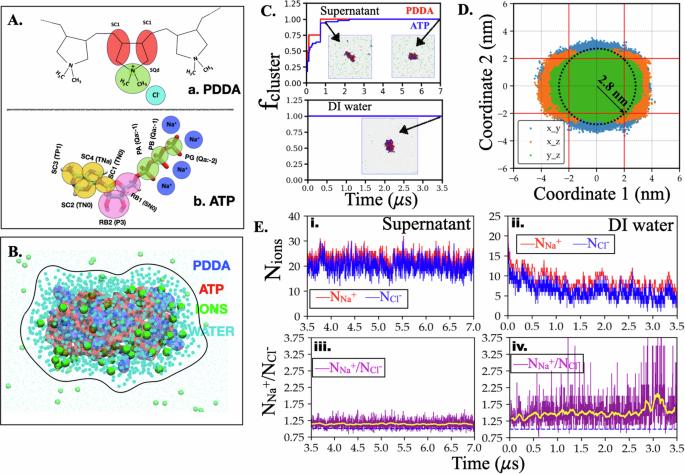The molecular picture of the local environment in a stable model coacervate
IF 5.9
2区 化学
Q1 CHEMISTRY, MULTIDISCIPLINARY
引用次数: 0
Abstract
Complex coacervates play essential roles in various biological processes and applications. Although substantial progress has been made in understanding the molecular interactions driving complex coacervation, the mechanisms stabilizing coacervates against coalescence remain experimentally challenging and not fully elucidated. We recently showed that polydiallyldimethylammonium chloride (PDDA) and adenosine triphosphate (ATP) coacervates stabilize upon their transfer to deionized (DI) water. Here, we perform molecular dynamics simulations of PDDA-ATP coacervates in supernatant and DI water, to understand the ion dynamics and structure within stable coacervates. We found that transferring the coacervates to DI water results in an immediate ejection of a significant fraction of small ions (Na+ and Cl−) from the surface of the coacervates to DI water. We also observed a notable reduction in the mobility of these counterions in coacervates when in DI water, both in the cluster-forming and slab simulations, together with a lowered displacement of PDDA and ATP. These results suggest that the initial ejection of the ions from the coacervates in DI water may induce an interfacial skin layer formation, inhibiting further mobility of ions in the skin layer. Transferring coacervates based on polydiallyldimethylammonium chloride and adenosine triphosphate into deionized water has been experimentally demonstrated to stabilize them against coalescence. Here, molecular modeling and simulations are used to study the coacervation and stabilization of the relevant polyelectrolyte mixture, systematically investigating the structural and dynamic properties that lead to stability.

稳定模型凝聚态局部环境的分子图谱
复合凝聚态在各种生物过程和应用中发挥着至关重要的作用。尽管在理解驱动复合凝聚的分子相互作用方面取得了重大进展,但稳定凝聚体防止凝聚的机制仍具有实验挑战性,尚未完全阐明。我们最近的研究表明,聚二烯丙基二甲基氯化铵(PDDA)和三磷酸腺苷(ATP)凝聚体在转移到去离子水中后会变得稳定。在此,我们对上清液和去离子水中的 PDDA-ATP 凝聚态进行了分子动力学模拟,以了解稳定凝聚态中的离子动力学和结构。我们发现,将共蒸物转移到去离子水中会导致大量小离子(Na+ 和 Cl-)立即从共蒸物表面喷射到去离子水中。在成团模拟和板块模拟中,我们还观察到这些反离子在去离子水中的流动性明显降低,同时 PDDA 和 ATP 的位移也降低了。这些结果表明,离子最初从去离子水中的共凝聚体中喷出时,可能会诱发界面表皮层的形成,从而抑制离子在表皮层中的进一步移动。实验证明,将基于聚二烯丙基二甲基氯化铵和三磷酸腺苷的凝聚态水转移到去离子水中可以使其稳定,防止凝聚。在此,我们利用分子建模和模拟来研究相关聚电解质混合物的凝聚和稳定,系统地研究了导致稳定的结构和动态特性。
本文章由计算机程序翻译,如有差异,请以英文原文为准。
求助全文
约1分钟内获得全文
求助全文
来源期刊

Communications Chemistry
Chemistry-General Chemistry
CiteScore
7.70
自引率
1.70%
发文量
146
审稿时长
13 weeks
期刊介绍:
Communications Chemistry is an open access journal from Nature Research publishing high-quality research, reviews and commentary in all areas of the chemical sciences. Research papers published by the journal represent significant advances bringing new chemical insight to a specialized area of research. We also aim to provide a community forum for issues of importance to all chemists, regardless of sub-discipline.
 求助内容:
求助内容: 应助结果提醒方式:
应助结果提醒方式:


